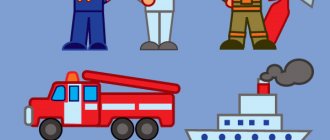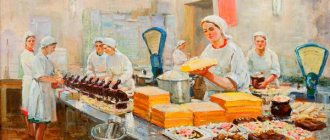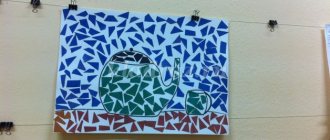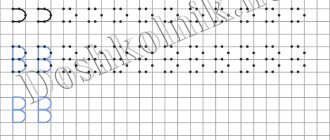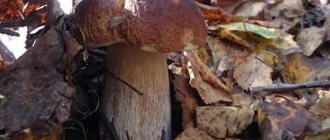Abstract on the topic “Mushrooms”
Summary of a lesson in the senior group on the topic “Mushrooms”
Goal: to create conditions for the development and consolidation of children’s ideas about mushrooms, appearance features, and places of growth. Objectives: Educational: - teach to distinguish between edible and poisonous mushrooms; -expand and activate vocabulary on the topic. Correctional and developmental: - develop cognitive interest; — develop attention when solving game tasks; - develop visual and auditory perception, attention, memory; - develop coordination of words and movements; - develop fine and gross motor skills; - enrich visual impressions; Educational: - cultivate interest in the environment; Equipment and tools: visual material depicting mushrooms, cut-out pictures, cards with mushrooms, basket, notebooks
1. Solving the riddle.
Who sits on a strong leg In the brown leaves by the path A grass hat has stood up - Is there no head under the hat?
( mushroom
)
2. Conversation about mushrooms.
That's right, these are mushrooms, how many of you have seen a real mushroom?
-Where do they grow? ( In the woods
) -Where else do mushrooms grow?
( in a clearing
) -What can you make from mushrooms? (
salt, dry, pickle, fry,
etc.) -What do all mushrooms have? (
stem and cap
)
Well done kids, there are a lot of mushrooms and they are all different. -What mushrooms do you know (children’s answers).
Do you want to get to know mushrooms better? A speech therapist introduces children to mushrooms using visual cards.
BOREZOVIK ( children repeat
) - that’s what they call it because it grows under a birch tree, the cap is round, the stem is thin, tall, the cap is dark brown.
BOLLOW ( children repeat
) - with a red hat, high leg. L: Why is it called that? D: Because it grows under the aspen tree.
FOXES ( children repeat
) - with a low stem, concave cap.
L: Why are they called chanterelles, guys? D: - Because they are red, like the fox. This is OPYATA ( children repeat
) - friendly guys, they grow up in large families on tree stumps.
CHAMPIGNONS ( children repeat
) are white mushrooms with a round cap that looks like half a ball.
These are RUSSUL ( children repeat
) - their caps can be red, yellow, green and other colors, the legs are white, the mushrooms are fragile.
L: Guys, are all mushrooms edible? D: No. L: - Why? D: Because they are poisonous. L: Well done. Let's get to know them so that we never confuse them with edibles.
L: - FLY AKOMOR ( children repeat
) is a poisonous mushroom. Thin white leg with a skirt, red cap with white spots.
PALE TOADSALD ( children repeat
) is the most poisonous mushroom.
This mushroom has a long thin stem and a pale gray cap. I'm not used to being liked. Anyone who eats me will get poisoned. 3. “Cut-out pictures”
Cut-out pictures on the topic “Mushrooms” are distributed. Children assemble a whole from parts and name their mushroom.
4. Game “Count the mushrooms” (count up to 5)
Pictures depicting mushrooms are distributed.
Children name how many mushrooms are in the picture. ( Example: I have three chanterelles. I have five mushrooms.) 5. Game “Edible and Inedible”
L: -You have pictures with mushrooms on your tables.
Now collect only those with edible mushrooms in the basket. (The others explain why they didn’t put their mushrooms in the basket). 6. Physical school
In the morning, the children went into the forest
(steps with high legs raised)
And in the forest they found mushrooms (
measured squatting),
They bent over, collected
(bending forward),
On the way they got lost
(rhythmic spreading of arms to the sides).
7.Game
"4 is extra." L: Look at the pictures. Which item is missing? Why? (chanterelles, russula, honey mushrooms, banana). D: - Banana. Because banana is a fruit.
8.Work in a notebook. ?
Trace the mushrooms along the dots with a simple pencil.
9.
Bottom line.
Well done. Everyone tried very hard. Let's remember what we talked about today? What types of mushrooms are there? Well, now the one who can name the mushrooms that grow on stumps, that have multi-colored caps, that grow under birch trees, that grow under aspen trees , that have white peas on their caps will
Lesson notes “Mushrooms” for 2nd grade.
Look at the picture in the textbook on page 86. What does it show? That's right, mushrooms. But mushrooms not only have a name like ours, they also have something very interesting! Do you guys all know your addresses? It turns out that mushrooms also have... their own address! The mushroom can always be found at this address. But not everyone knows this “mushroom address”, but only the most attentive to nature people. Look at the boletus, where do you think it can live? That's right, boletus can be found under aspen trees. It is not difficult to guess where the boletus lives, under a birch tree. The porcini mushroom is otherwise called boletus, and this is not without reason, because such a mushroom can be found in a pine forest. But not all mushrooms have an address in their name; you will need to remember them. Milk mushroom, like boletus, most often grows under birch trees. Fly agarics live in coniferous forests, less often under birch trees. Chanterelles grow as a whole family in mixed forests. But mushrooms - umbrellas and russula feel great in any forest.Please open your textbook to page 87 and read the first paragraph carefully. What does it say? We have a mushroom hanging on the board, let's try to correctly arrange its components. Where is the cap of a mushroom? That's right, guys. The cap is necessary for the fungus to reproduce; it contains spores. Where is the stem of the mushroom? That's right, the leg holds the cap and connects it with the mycelium. The mycelium is the underground part of the fungus through which it feeds.
Okay, open your workbook to page 52 and sketch the structure of a mushroom, labeling all its parts.
Guys, we went into the forest, but does anyone know how to pick mushrooms correctly?
Now I will show you three ways to pick mushrooms and we will determine which one suits us. (the teacher uses plasticine models to show three methods: tear it out, cut it off with a knife, unscrew it)
What method will we use to collect mushrooms?
We know where to look for mushrooms, how to collect them, but we don’t know what mushrooms can be collected. Do you want to know?
I suggest watching the cartoon and figuring out which mushrooms are harmful. What harmful mushrooms were mentioned in the cartoon?
Guys, you should also not pick mushrooms growing near roads, even if they are not considered poisonous - they absorb the poisonous exhaust gases of passing cars and become poisonous themselves. Old mushrooms are not suitable for food; they can also become poisonous.
Fizminutka
Let's consider the problem. In pairs, you can discuss and raise your hand when you are ready to answer.
Two friends went into the forest to pick mushrooms. They wandered through the forest for a long time, but there were no mushrooms. Occasionally we came across faded old ones and fly agaric mushrooms, which Vova knocked down with a stick.
“Why are you doing this?” Kolya asked, “After all, the forest and the animals need them!”
“They’re inedible, toadstools,” Vova answered.
Which boy is right?
It’s true that if mushrooms are poisonous to us, this does not mean that they are poisonous to nature, so there is no need to knock them down or pull them out.
Abstract of the educational activity “Mushrooms” for introducing children to the world around them in the senior group
Educator:
That's right, squirrels sometimes dry them for the winter.
And moose swallow them whole, sometimes several at a time. For what? ( children's answers
).
Educator:
Fly agarics for moose are a medicine that helps them get rid of worms. That's it! In general, there is nothing unnecessary in nature. If a person doesn’t need something, someone else may need it.
Educator:
Remember, guys, fly agaric and toadstool are poisonous mushrooms and they are inedible for humans.
Repeat - inedible mushrooms (children repeat).
Educator:
Now you know which mushrooms are edible and which are poisonous.
Physical education and gymnastics for the eyes “Rain”.
Educator:
Guys, hold hands and let's walk along the winding path into the forest.
(Children follow the teacher like a snake, stand in a circle for eye exercises “Rain”
).
Educator:
The first drop fell - drop!
( Finger imitate the movements of a drop with a finger and follow with their eyes
)
And the second one ran...
We looked at the sky: (Looking up)
The droplets began to sing "drip-drip".
Our faces got wet, we wiped them. (Wipes face with hands)
The shoes - look - they became wet. (Point hands down and look at feet)
We will shrug our shoulders together,
Let's shake off the droplets. (Move their shoulders from side to side, hands on the belt)
We will run away from the rain, (They run after each other in a circle)
Let's sit under a bush. (Squat
)
Educator:
What do you call people who pick mushrooms? (mushroom pickers)
Educator:
That's right - people who go into the forest to pick mushrooms are called mushroom pickers. Mushroom picking is called “silent hunting.” Why do you think? (Children's answers).
Educator:
We are not masters in the forest, but guests. And since you’ve already come to visit, respect the owners of the forest: the plant and animal forest people. How to behave correctly in the forest? (Children's answers).
Educator:
Don't make noise, don't litter, don't trample, don't pick mushrooms by the roots.
Educator:
For regular hunting they go with guns, and for mushroom hunting - with knives. Why, do you know? (Children's answers).
Educator:
Real mushroom pickers take care of the forest and never pull mushrooms out of the ground by the roots, as this can damage the mycelium, and then small mushrooms will not grow in this place. The mushroom must be carefully cut with a knife.
Consolidation
Didactic game “Which mushroom do we take?”
Educator:
I suggest collecting mushrooms in a basket. I name a mushroom, if it’s edible, you clap your hands, if it’s inedible, you stomp your foot, and we don’t take this mushroom.
(game being played)
Didactic game “Collect a picture” - cut pictures prepared on the table.
Educator:
Oh, while you and I were picking mushrooms in a basket, someone scattered mushrooms on the table.
